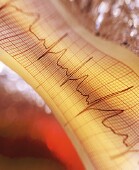
TUESDAY, April 27 (HealthDay News) — Adding a computed tomography test to measure calcium in coronary arteries improves predictions of future heart disease, a new study finds, but no one knows yet whether it’s worth the cost and risk due to radiation exposure.
“This kind of evidence gives encouragement to go on and do additional testing, but it shouldn’t convince us that this test should be done routinely,” said Dr. Philip Greenland, a professor of preventive medicine at Northwestern University Feinberg School of Medicine, and a member of the team reporting the study in the April 28 issue of the Journal of the American Medical Association.
Computed tomography uses X-rays to get a detailed picture of heart structure. Its use in diagnosing existing heart disease has become controversial because X-ray exposure increases the risk of cancer. The new study of nearly 6,000 healthy Americans was done to see whether the technique could improve the predictive power of existing cardiac risk factors such as high blood pressure, high cholesterol and obesity.
The study began in July 2000 and ran through May 2008. It used two models to predict the five-year risk of a heart attack, resuscitated cardiac arrest or death from coronary heart disease: the traditional risk factors; or those risk factors plus the coronary artery calcium score.
At 5.8 years, the participants had experienced 209 coronary heart disease problems and 122 “major events” — that is, heart attacks, deaths from coronary heart disease, or cardiac arrest followed by a resuscitation.
The second model, which used the regular risk factors plus the calcium scan, was able to predict an additional 23 percent of the participants who would go on to experience a harmful cardiovascular event. In addition, 13 percent the model reclassified as low-risk did not experience an adverse event.
But does that added predictive power make a difference in terms of saving lives and reducing unnecessary treatment?
“We didn’t look at that,” Greenland said. “What we can say here is that additional testing looks like it improves prediction. Whether it improves clinical outcome requires a different kind of study.”
The first steps toward such a study have been taken. “We are in discussions with the National Heart, Lung, and Blood Institute and have been encouraged to submit a proposal,” Greenland said.
Such a study might involve tens of thousands of participants and cost over $100 million, said Dr. Andrew J. Einstein, director of cardiac computed tomography research at Columbia University Medical Center in New York City.
The study would aim at determining whether more intensive treatment of traditional risk factors would improve survival of people classified as high-risk by the coronary artery calcium score. “No study has compared patients who had intensive preventive therapy with those who didn’t and see if it makes a difference in terms of the number of heart attacks people have,” Einstein said. “That study would be the ideal.”
Such a trial needn’t be as expensive as Einstein estimates, Greenland said. He puts the cost at “between $29 million and $50 million” and notes that the U.S. Institute of Medicine lists that kind of trial among the top 100 that should be done using funds provided for comparative effectiveness research in the newly approved health care program.
Cancer risk and cost are also parts of the equation. A well-controlled computed tomography scan gives about twice the radiation exposure as a mammogram, Greenland said. A new large-scale trial could show whether the added risk is justified by the number of lives saved, and the same is true of the cost, estimated to run between $200 and $600 per scan.
“Concern about radiation for any individual is minimal, and the cancer issue is 20 years down the line,” said Dr. Joseph Ladapo, a clinical fellow in medicine at Harvard Medical School and Beth Israel Deaconess Medical Center in Boston. Incidental findings of a scan, such as possible lung problems, can also help justify its widespread use, Ladapo said.
But the time for widespread use has not arrived, Greenland noted. The new study results “are not an endorsement for screening,” he said.
More information
The why and how of a coronary calcium scan is described by the U.S. National Heart, Lung, and Blood Institute.

